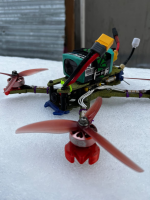harrisonpatm
10 kW
- Joined
- Aug 8, 2022
- Messages
- 824
I am briefly dipping my toes into the DIY flying drone building world, and one thing is bothering me, based on my current knowledge of larger e-vehicles: How are these tiny controllers capable of powering not one, but 4, BLDC's at 30-50 amps each? Based on reviews it seems like they actually are capable of their rated specs (at least the name-brand controllers). But they're either 20mm or 30mm squares, absolutely tiny!
Here's a generic board-only bldc controller that I picked off amazon at random, only about 20A capable. It's 63x43mm
Here's a well-recommended drone controller, controls 4ea bldc's, 50 amps each, and it's only 38x41mm
If I had to guess, I'd say the two main factors are that drone's operate on lower voltage (rarely over 6s Li-Ion for hobbyists, while ebikes range in 7-14s for example), and that they only are expected to run for 10-30 minutes at most. Some small ones are only rated for like 4-10 minutes run time.
Are we in the electric vehicle community missing out on something?!? Lol
Here's a generic board-only bldc controller that I picked off amazon at random, only about 20A capable. It's 63x43mm
Here's a well-recommended drone controller, controls 4ea bldc's, 50 amps each, and it's only 38x41mm
If I had to guess, I'd say the two main factors are that drone's operate on lower voltage (rarely over 6s Li-Ion for hobbyists, while ebikes range in 7-14s for example), and that they only are expected to run for 10-30 minutes at most. Some small ones are only rated for like 4-10 minutes run time.
Are we in the electric vehicle community missing out on something?!? Lol




